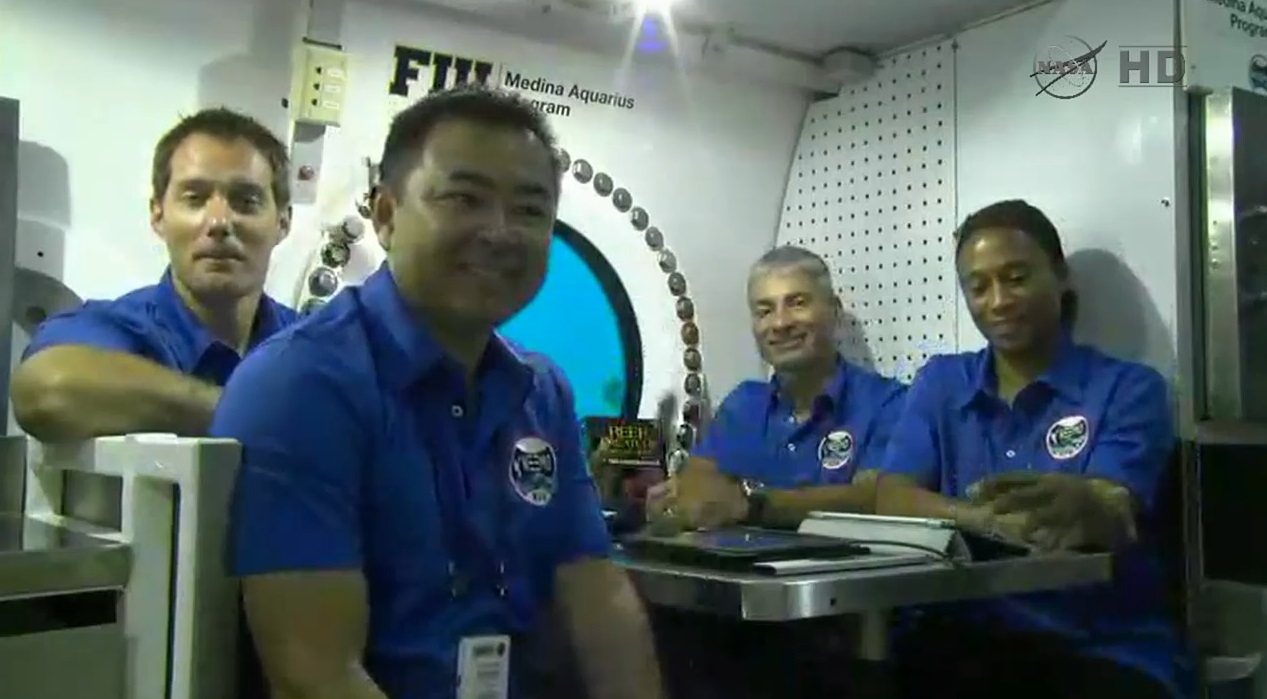Astronauts Simulate Deep-Space Mission in Underwater Lab

Plenty of astronauts practice spacewalks in the water, but a crew currently living in an underwater lab plans to introduce a surprising twist to its aquatic excursions: They will create a 10-minute communications delay with Mission Control, simulating what speaking with people on Earth could be like in deep space.
The four astronauts participating in the nine-day NASA Extreme Environment Mission Operations (NEEMO) 18 mission will perform underwater "spacewalks" in which they pretend to be on an asteroid far from Earth, where radio communications between the two locales would take minutes, not seconds, as communication from the International Space Station does.
They will do a spacewalk "circuit," in which crew members will make a rough circle of the area, aiming to come back to the same spot by the time the 10 minutes are up. By then, Mission Control can give astronauts instructions on which spots to sample, crew members said during a news conference Wednesday (July 23). [9 Coolest Mock Space Missions]
"We'll be testing out those tools if we did go to an asteroid," said Jeanette Epps, a NASA astronaut who is part of the NEEMO 18 crew. NASA officials hope to send astronauts to an asteroid robotically pulled into orbit around the moon sometime in the mid-2020s.
Epps spoke to members of the press from 62 feet (19 meters) underwater in the Aquarius lab off the coast of Key Largo, Florida. NASA astronaut Mark Vande Hei, Japanese astronaut Akihiko Hoshide and European Space Agency astronaut Thomas Pesquet are also living and working in the lab.
Adaptability is key
Although the mission is a simulation, malfunctions do occur sometimes. Communications problems between the "spacewalkers" and Mission Control affected operations earlier in the mission, said Vande Hei.
"Thomas and I were supposed to spend the entire time doing experiments, while Aki and Jeannette were doing the spacewalk, but because of the communications problems, I had to abort my science," he said. "Thomas went ahead and did them all, which was great, and I focused on the spacewalks."
Breaking space news, the latest updates on rocket launches, skywatching events and more!
There are many similarities to space in this confined environment, ranging from the need to balance science tasks with maintenance tasks, to living together in close quarters, to having the time tightly scheduled, the astronauts noted.
There is also significant international collaboration, with astronauts from three partner agencies working together this time in the NEEMO 18 crew. When asked by a journalist how space relations are with Russia amid the Ukraine crisis, the astronauts emphasized all was well and that working together is required in space.
"I hope the future holds a lot of cooperation," Vande Hei said. "The fact we have an international program to explore space has helped us keep the program going between administrators, and regardless of what is going on politically."
Experiments and cubbyholes
The experiments astronauts are doing during the mission, which began Monday (July 21), range from the physical to the behavioral. For example, each of the crew members sports a sensor that records how close the crew members work with each other inside the school-bus-size habitat.
Communications with NEEMO Mission Control is usually constant, and there is the ability to send items to and from the habitat as needed. Also living inside the habitat are two support staff who are assisting with Aquarius maintenance and systems, as required. The crew members also have Internet and phone service to talk with family and friends.
While space is tight in the habitat, Epps said there is a "pretty big" cubbyhole where astronauts can store their T-shirts, shorts, underwear, regular toiletry items and anything more personal. "We're not really deprived of much," she said.f
Follow Elizabeth Howell @howellspace. Follow us @Spacedotcom, Facebook and Google+. Original article on Space.com.

Elizabeth Howell (she/her), Ph.D., was a staff writer in the spaceflight channel between 2022 and 2024 specializing in Canadian space news. She was contributing writer for Space.com for 10 years from 2012 to 2024. Elizabeth's reporting includes multiple exclusives with the White House, leading world coverage about a lost-and-found space tomato on the International Space Station, witnessing five human spaceflight launches on two continents, flying parabolic, working inside a spacesuit, and participating in a simulated Mars mission. Her latest book, "Why Am I Taller?" (ECW Press, 2022) is co-written with astronaut Dave Williams.


